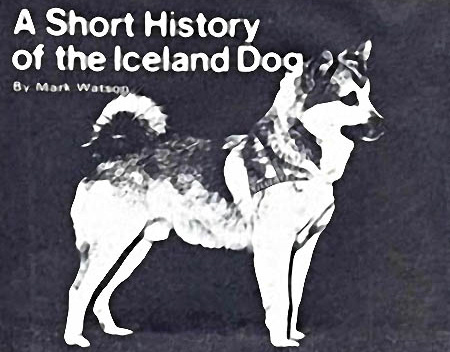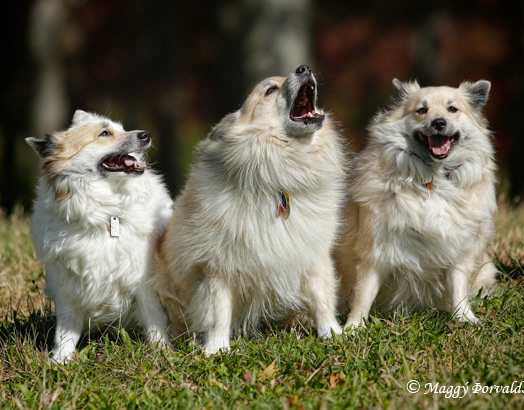Breed Expert and FCI Judge Guðrún Ragnars Guðjohnsen recently attended the annual Icelandic Sheepdog International Cooperation (ISIC) meeting. We thought we’d ask her about the “State of the Union.”
DRM: How is the Icelandic Sheepdog doing worldwide?
GRG: We have accomplished many good things for the breed in the sixteen years that the ISIC has worked together. There are now ten breed clubs from ten kennel clubs and ten countries working for the Iceland Dog on type, health, temperament and working ability, which is typical of the breeds in the FCI’s Group 5 (Spitz and Primitive Types), Section 3 (Nordic Watchdogs and Herders). One of our most important accomplishments is our worldwide database that includes over 11,000 Icelandic Sheepdogs. This allows us to look at the breed as one population rather than separate populations by country and helps us make sound breeding decisions.
GRG: We have accomplished many good things for the breed in the sixteen years that the ISIC has worked together. There are now ten breed clubs from ten kennel clubs and ten countries working for the Iceland Dog on type, health, temperament and working ability, which is typical of the breeds in the FCI’s Group 5 (Spitz and Primitive Types), Section 3 (Nordic Watchdogs and Herders). One of our most important accomplishments is our worldwide database that includes over 11,000 Icelandic Sheepdogs. This allows us to look at the breed as one population rather than separate populations by country and helps us make sound breeding decisions.
DRM: What would you improve upon?
GRG: Maybe it is not a question of improving but more to protect the good things we already have. All breed clubs are working together towards that goal, meeting annually, discussing issues and working openly together. Each country’s breed club sends two representatives to the yearly seminars; the president of the club and the genetic or breeding committee chairperson. I am extremely grateful and happy for the serious and good work that goes on in ISIC.
GRG: Maybe it is not a question of improving but more to protect the good things we already have. All breed clubs are working together towards that goal, meeting annually, discussing issues and working openly together. Each country’s breed club sends two representatives to the yearly seminars; the president of the club and the genetic or breeding committee chairperson. I am extremely grateful and happy for the serious and good work that goes on in ISIC.
DRM: AKC Judges often ask us what, “one thing” they should focus on in the ring. What would you tell them?
GRG: The overall expression and type - and even though the breed is not a “head breed” the mild, friendly and almost smiling expression with the expressive dark eyes is very typical for the breed. A well curled and high set tail, carried over the back is also an important breed detail. Proportions are important: the length of the body from the point of shoulder to the point of buttock is greater than the height at withers, depth of chest is equal to the length of the foreleg, and the muzzle should be clearly shorter than the skull. Good angulations for a Nordic herding Spitz, good bone, strength and stamina are also important. Common faults often are thin boned dogs with narrow heads, snipe noses, not dark enough eyes and too big ears. We also have to aim for straighter legs mostly in the rear.
GRG: The overall expression and type - and even though the breed is not a “head breed” the mild, friendly and almost smiling expression with the expressive dark eyes is very typical for the breed. A well curled and high set tail, carried over the back is also an important breed detail. Proportions are important: the length of the body from the point of shoulder to the point of buttock is greater than the height at withers, depth of chest is equal to the length of the foreleg, and the muzzle should be clearly shorter than the skull. Good angulations for a Nordic herding Spitz, good bone, strength and stamina are also important. Common faults often are thin boned dogs with narrow heads, snipe noses, not dark enough eyes and too big ears. We also have to aim for straighter legs mostly in the rear.
DRM: In terms of this, how do you think that breeders worldwide are doing?
GRG: I think we are on the right track with our world wide database; genetic work and unique cooperation between breed clubs in ISIC and close contact with Iceland, the breed’s homeland.
GRG: I think we are on the right track with our world wide database; genetic work and unique cooperation between breed clubs in ISIC and close contact with Iceland, the breed’s homeland.
In my visits to the U.S., I met some of your judges, all of them very competent and lovely people, and I think the breed is in good hands in the USA, with your competent judges, the AKC and your breed club, the ISAA. I also met many breeders and dog owners with their lovely dogs, all serious about doing the best for the breed. Give my best to all these nice people and I wish you all the best of luck and success with this wonderful breed in the future.
Donna R. McDermott, MPPA
eyjahunda@gmail.com
eyjahunda@gmail.com
Originally published in AKC Gazette, March. 2012 edition, Used with Permission




